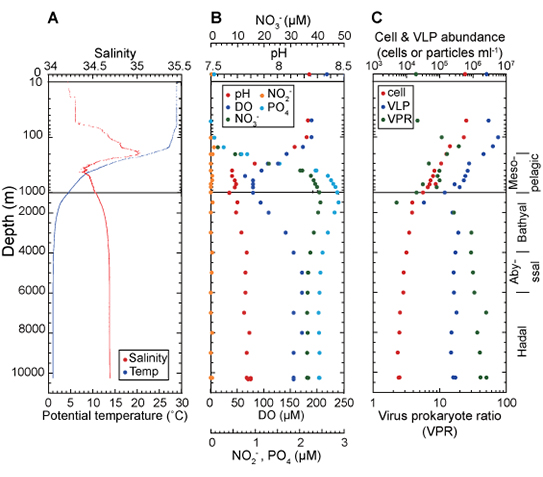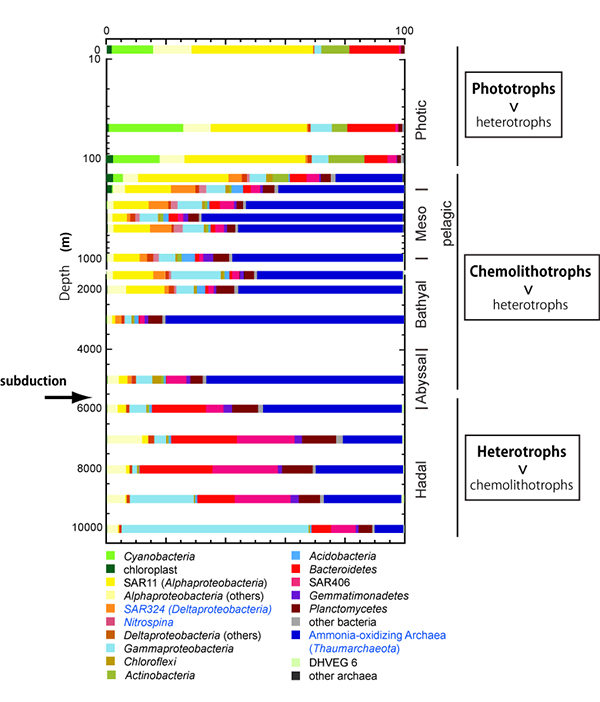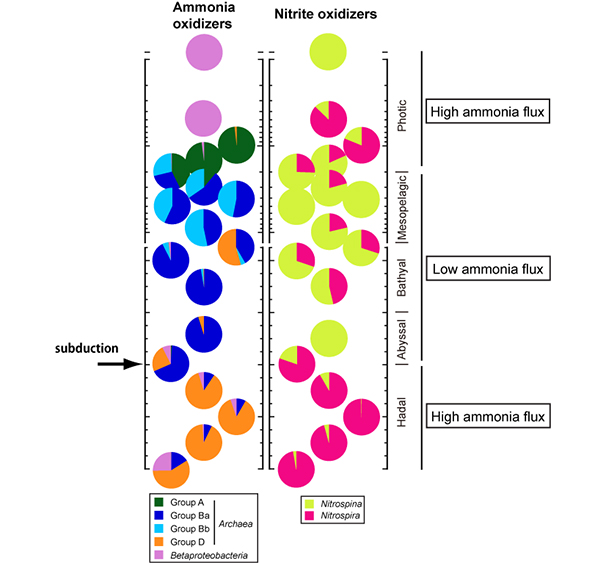A joint study group of Japan Agency for Marine-Earth Science and Technology (JAMSTEC), Tokyo Tech, Yokohama City University and University of Tokyo identified trench microbial communities in water masses (a body of oceanic water characterized with a distinctive temperature and salinity) in the Challenger Deep, the Mariana Trench (6,000-10,257 m) for the first time. Being distinct from abyssal microbial communities, they clearly demonstrated existence of unique microbial ecosystems in hadal trench waters.
Although microbial explorations for hadal sediments began in the 1950s, the hadal water has been the least-explored microbial biosphere. In June 2008, the study group, led by Dr. Takuro Nunoura at JAMSTEC, took water samples during the JAMSTEC's research vessel Kairei KR08-05 cruise using a remotely operated vehicle (ROV) ABISMO at a station on the Challenger Deep (11-22.25′N, 142-42.75′E, at the depth of 10,300m). Then, molecular ecological and geochemical analyses were carried out.
As a result, it became clear that microbial community compositions and functions in hadal waters (below 6,000m) are distinct from overlying bathyal and abyssal microbial communities (at depth of 2,000-5,000m) with dominance of heterotrophic bacteria(1), whereas other physical and chemical conditions such as temperature, salinity and dissolved nutrients are comparable to those in abyssal oceans. It provides absolutely new insight into understanding of marine microbial communities.
Since the Mariana Trench is geographically and hydrotopographically isolated from other trenches, there cannot be organic matters completely different from those in the upper abyssal waters, including possibility of flux from other trenches. It is, therefore, considered that these microbial ecosystems associated with the hadal trench waters are supported by endogenous recycling of organic matter from trench slopes disrupted due to earthquakes, etc. In other words, hadal/trench biosphere is likely to be associated with formation of trench topography as an ecosystem
This study was partially supported by a Grant-in-Aid for Scientific Research from the Japan Society for the Promotion.
These study results have been posted on a scientific journal, Proceedings of the National Academy of Science of the United States of America on February 24, 2015(JST).
Explanations of Technical Terms
1.Heterotrophic bacteria
Living organisms that use organic compounds for obtaining carbons necessary for nutrition. All animals and fungi as well as many bacteria and archaeon are heterotrophic. Heterotrophic bacteria cannot fix carbon so needs organic compounds synthesized by other living organisms. In contrast, plants are autotrophs.
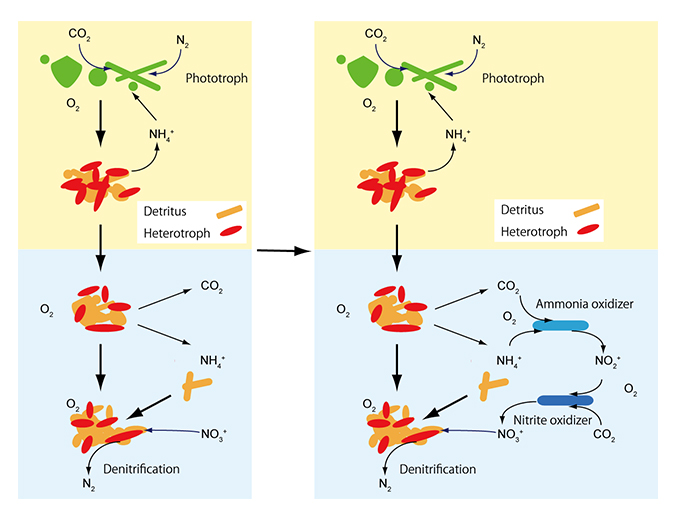
Fig. 1: Diagram showing deep water ecosystems
The left shows an image based on traditional ideas, while the right based on recent new insight. At present, chemolithotroph, which uses reductive sustances such as ammonia and compound of sulfur generated by organics decomposition as its principal energy source, is recognized as an important component in deep water microbial communities.
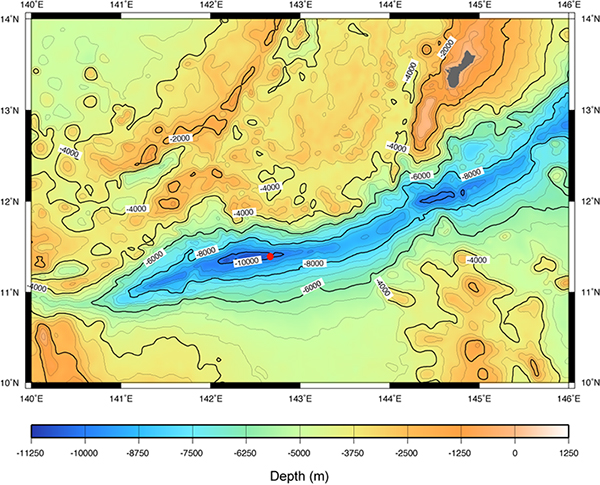
Fig. 2: Ocean floor topography of the Challenger Deep, Mariana Trench
The red circle shows the sampling site. This data was prepared by JAMSTEC based on NOAA data.
- Fig. 3:(A)Temperature and salinity, (B)oxygen, nitrate, nitrite, and phosphate concentrations and pH, and (C) the abundance of prokaryotic cells and virus-like particles (VLPs) and VLP prokaryote ratio (VPR) along the water column in the Challenger Deep.
- Fig. 4:Prokaryotic SSU rRNA gene community composition along the water column in the Challenger Deep. Representative chemolithotrophic groups are shown by blue font.
- Fig. 5:The abundance of subgroups of amoA (gene of ammonia monooxygenase subunit α) of ammonia oxidizers (ammonia-oxidizing Archaea and Betaproteobacteria) and SSU rRNA genes of nitrite-oxidizing bacteria (Nitrospina and Nitrospira) along the water column in the Challenger Deep.
Each group's preference to electron donors is considered to be the following order of high concentration: 1) Ammonia oxidizers: Betaproteobacteria > Group D > Group A > Group B; and 2) Nitrite oxidizers: Nitrospira > Nitrospina
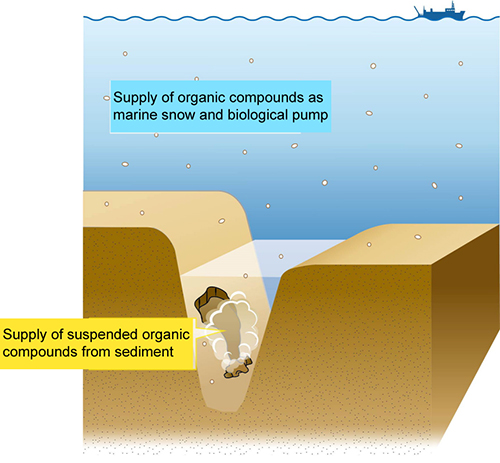
Fig. 6: Diagram showing hadal trench biosphere
Reference
Authors: |
Takuro Nunoura1, Yoshihiro Takaki1 Miho Hirai1, Shigeru Shimamura1, Akiko Makabe123, Osamu Koide1, Tohru Kikuchi4, Junichi Miyazaki1, Keisuke Koba2, Naohiro Yoshida3, Michinari Sunamura5, Ken Takai1 |
Affiliation: |
1JAMSTEC, 2Tokyo University of Agriculture and Technology, 3Tokyo Institute of Technology, 4Yokohama City University, 5University of Tokyo |
Title of original paper: |
Hadal biosphere: insight into the microbial ecosystem in the deepest ocean on Earth |
Journal: |
Proceedings of the National Academy of Science |
DOI: |
|
. Any information published on this site will be valid in relation to Science Tokyo.




